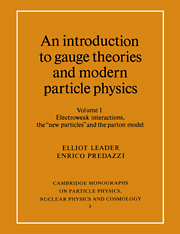Book contents
- Frontmatter
- Contents
- Preface
- Acknowledgements
- Notational conventions
- Note added in proof: the discovery of the top quark (?)
- Note added in proof: the demise of the SSC
- 1 Field theory and pre-gauge theory of weak interactions
- 2 The need for a gauge theory
- 3 Spontaneous symmetry breaking: the Goldstone theorem and the Higgs phenomenon
- 4 Construction of the standard model
- 5 Lowest order tests of the SM in the leptonic sector
- 6 The Higgs boson
- 7 The standard model beyond lowest order
- 8 e+e− physics and the standard model
- 9 Extension to the hadrons; quark–lepton universality
- 10 Phenomenology of semi-leptonic reactions
- 11 The discovery of the narrow vector resonances
- 12 Hidden flavour bound states
- 13 Open heavy flavours
- 14 The heavy lepton τ
- 15 Towards the parton model—deep inelastic scattering
- 16 The quark–parton model
- 17 Experimental tests of the quark-parton model
- Appendix 1 Elements of field theory
- Appendix 2 Feynman rules for QED, QCD and the SM
- Appendix 3 Conserved vector currents and their charges
- References
- Analytic subject index for vols. 1 and 2
15 - Towards the parton model—deep inelastic scattering
Published online by Cambridge University Press: 19 March 2010
- Frontmatter
- Contents
- Preface
- Acknowledgements
- Notational conventions
- Note added in proof: the discovery of the top quark (?)
- Note added in proof: the demise of the SSC
- 1 Field theory and pre-gauge theory of weak interactions
- 2 The need for a gauge theory
- 3 Spontaneous symmetry breaking: the Goldstone theorem and the Higgs phenomenon
- 4 Construction of the standard model
- 5 Lowest order tests of the SM in the leptonic sector
- 6 The Higgs boson
- 7 The standard model beyond lowest order
- 8 e+e− physics and the standard model
- 9 Extension to the hadrons; quark–lepton universality
- 10 Phenomenology of semi-leptonic reactions
- 11 The discovery of the narrow vector resonances
- 12 Hidden flavour bound states
- 13 Open heavy flavours
- 14 The heavy lepton τ
- 15 Towards the parton model—deep inelastic scattering
- 16 The quark–parton model
- 17 Experimental tests of the quark-parton model
- Appendix 1 Elements of field theory
- Appendix 2 Feynman rules for QED, QCD and the SM
- Appendix 3 Conserved vector currents and their charges
- References
- Analytic subject index for vols. 1 and 2
Summary
We have seen in earlier chapters that there seems to be a close parallelism between the sets of leptons and the sets of quarks, at least in so far as the unified weak and electromagnetic interaction is concerned. The leptons are essentially ‘point-like’ in their behaviour, and it is not inconceivable that the quarks too enjoy this property. In that case we might expect the hadrons to behave, in certain situations, in a less complicated fashion than usual. If we think of the hadrons as complicated ‘atoms’ or ‘molecules’ of quarks, then at high energies and momentum transfers, where we are probing the inner structure, we may discover a relatively simple situation, with the behaviour controlled by almost free, point-like constituents. The idea that hadrons possess a ‘granular’ structure and that the ‘granules’ behave as hard point-like, almost free (but nevertheless confined) objects, is the basis of Feynman's (1969) parton model.
We shall discuss the model in some detail in the following chapters, in particular the question as to whether the partons can be identified with the quarks. The introductory material of the chapter is largely based upon lecture notes of F. Close (1973) (see also Close, 1979). We shall also study more sophisticated versions of the picture, wherein the quarkpartons are not treated as free, but are allowed to interact with each other via the exchange of gluons, in the framework of QCD.
- Type
- Chapter
- Information
- An Introduction to Gauge Theories and Modern Particle Physics , pp. 316 - 351Publisher: Cambridge University PressPrint publication year: 1996



